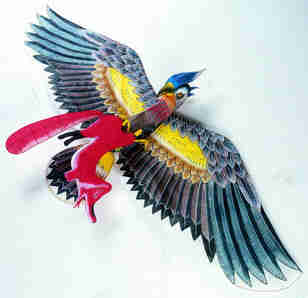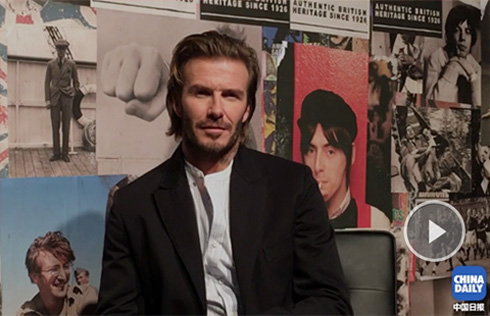Chinese traditional kite craft

Kites were invented by the Chinese people over 2000 years ago. About in the 12th century, Chinese kite spread to the West, and the oriental and Western kite culture was formed after years of development. In this process, Chinese traditional culture integrated with the kite craft, and finally formed the kite culture with unique characteristics.
Uses of kite have been changed several times in history. According to historical record, kite was first used in military. In the mid Tang Dynasty (618-907), in which the society was stable and peaceful, the use of kites was gradually changed from military to entertainment. With the innovation of papermaking, the raw material of kite changed from silk to paper. Kite became popular among civilians with a richer variety of forms and reached the peak point in the Song Dynasty (960-1279). Participated by the literary, the making and the decoration of kites underwent great development. Kite making became a profession due to the large demand.
The Ming (1368-1644) and Qing dynasties, was the peak period of the Chinese kite. The kites underwent great development in size, design, decoration and flying skills. Literators at that time made kite by themselves, and sent to relatives and friends as a gift, regarding it a literary pursuit. In recent years, kite flying has publicized as a sports activity as well as entertainment.
Workmanship of Chinese kites
The workmanship of Chinese kites can be summarized in four points: structuring, paperhanging, color drawing, and flying.
Structuring includes: selecting bamboo, chopping bamboo, bending bamboo, and joining bamboo.
Paperhanging includes: selecting material, cutting out, paperhanging, and cutting away or adding material as needed.
Color drawing includes: composing picture, outlining, dyeing (or coloring), and decorating.
Flying includes: selecting site and weather, choosing the kite, launching the kite into the air, adjusting the line, and controlling the kite.
To make a kite, first, the right kind of bamboo strips must be selected for the frame. It should be thick and strong for a kite of large dimensions in order to stand the wind pressure. The regular paper or sometime silk is used to cover the frame. Silk kites, especially, are more durable and generally of higher artistic value. Third, painting the kite may be done in each way.
China has a large area of territory. As a traditional culture and folk art, kite has formed unique style of different regions during its development, among which the most famous ones are the styles ofBeijing,Tianjin, Weifang in Shangdong Province, Sichuan andGuangdong Province.
Art genre & characteristics of Chinese kites
The art of Chinese kites has developed endlessly alongside the long history of the nation's cultural traditions. Each kind of kite art has its strong point due to its strong affinity with each rich and colorful historical period. The specific kite art and firmly relates with the music, dance, drama, folk-custom, and religion of their respective areas.
Various art systems and genres have formed over time. Generally, there are six kinds: Beijing kite, Weifang kite, Tianjin kite, Nantong kite, Jiangnan kite, andTaiwankite.
1. Beijing kites
Generally, there are seven kinds of artistic sculptures concerning Beijing kites: pricking swallow, hard wing, soft wing, symmetrical swallows, board, cluster, and canister.
The characteristics of Beijing kites include delicate frameworks, precise colored drawings, naturalness and gracefulness, and a high worthiness of being viewed and admired.
Typical Beijing kites are Caoshi, Jinshi, and Hashi kites, with new types of Beijing kites having come forth in a great number in recent years.
2. Weifang kites
Weifang kites, during a long development period, have passed its unique artistic individuality from generation to generation, with there being innovations in many aspects such as theme, sculpture, and painting. Meanwhile, this kind of kite has similarities with Beijing and Tianjin kites. Weifang kites fully demonstrate folk custom and vividness, which comes from adopting the advantages of other kinds of kites. Especially, in terms of the sculpture structure and painting color, Weifang kites transfer techniques of making woodblockNew Year picturesto kite making and exercise the skill of traditionalChinese paintingon drawing. It forms a unique feature of being exquisite in sculpture and delicate and gorgeous in artwork, which has become one of the important genres of Chinese kites.
The characteristics of the Weifang kites' artistic sculpture and style are their carefully selected materials, exquisite sculptures, delicateness, vivid images, bright-colored paintings, various kinds, and agile flying-off.
Among all the families of the Chinese kites, Weifang kites are affluent in themes, singular in the selection of material, magnified and transfigured in design, technical in painting by New Year's picture drawing skills, and ingenious in exercising the mechanics on flying-off, which composes its serene style and peculiar verve. It has a long history and for a long time has been famous all over the world.
3. Tianjin kites
The outstanding characteristics of Tianjin kites are the techniques of the framework and fastening and the colors of the designs. Based on traditional sculpture, Tianjin kites try to be unique, aiming to find something new and fresh in design and painting.
4. Nantong kites
The artistic style of Nantong kites can be generalized as being plain in sculpture, having a multi-tuned whistle, and demonstrating elegance on colored patterns. The basic style of Nantong kites can be divided into "fixed-snipe" and "unfixed-snipe." (what does snipe refer to?)
The most outstanding characteristic of Nantong kites is the sound device. Various whistles, big and small, with the quantity differing from one hundred to three hundred, are installed on the Nantong kites, hence the kites' nickname of "Symphony on Air."
5. Jiangnan kites
The typical Jiangnan kites are "Symmetrical Fish" and "Snipe-Eagle," both of which are traditional kites made by the techniques of woodblock print.
6. Taiwan kites
The characteristics of Taiwan kites' sculpture are that they place an emphasis on feature and are summarized and simplified as well as magnified and transfigured.
Taiwan kites are good at soft-winged structures.
One kind of the kite figure is shaped according to the imitation of the beautiful part of natural objects. The other kind is the simulation of natural objects. It mainly has 21 kinds approximately, such as peg-top,dragon, aniseed, Chinatown, Eagle, butterfly, dragonfly, goldfish, symmetrical fish, salangane (a kind of bird), seven stars, seagull, palace lantern, flyingtiger, centipede, big butterfly, big colored-butterfly, and so on.
Main categories of Chinese kites Chinese kites may be differentiated into four main categories:
1. Flat-Kites
Flat kites are constructed within a single plane, and are made of a completely rigid bamboo frame. Spars (longitudinal beams) frame all the four sides of the frame or of the frame segements. Most of these kites, which are very easy to fly, are flown with long tails to grant a stable in-flight behavior.
Flat kites are built in many forms and types, very often with pictorial motives from ancient myths and religious ideas, or very often with a picture of the ying-yang sign or the "Eight Diagrams" (a kind of ancient philosophy-related Chinese diagram).
2. Hard-winged kites
This kind of kite is made of two bamboo strips attached to a rectangular framework, which is covered with paper or silk to form a triangle to ensure a good wind-catching effect and good flight performance.
3. Soft-winged kites
A soft-wing kite is made of one bamboo strip. The wings of this kind of kite have rigid upper rims. The lower sections of all these wings are soft and flexible, hence allowing the kite to float in the air lightly and agilely. Very often these kinds of kites have more than one pair of wings, which are arranged one pair above the other. Pictorial motives and forms represent all kinds of birds, insects, fishes, and so on. When floating in the wind these kites give a very vivid visual flight performance. 4. Centipede kites
Centipedes are kites-trains with a dragonhead and a train of equally dimensioned kite disks. Head and disks are interconnected with one or more often three lines. Centipedes have enormous air traction power. These kites give an attractive and vivid in-flight view, especially when the wind moves and deforms the kite train. Centipedes with dragonheads are the typical form for this kind of kites and are a specialty of Weifang.
Besides the above four categories, there are also kites with no fixed shapes, but which have various motives and good flight performance.























